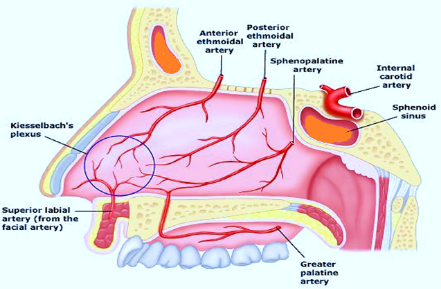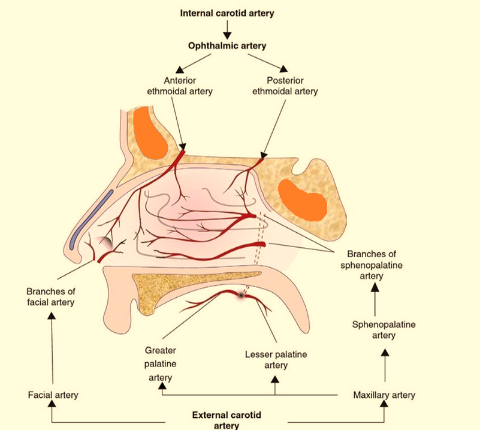
EPISTAXIS
Epistaxis is bleeding from the nose most commonly arising from the Little’s area of the nose. It is reported back to 5th century BC (Hippocrates).
Site of epistaxis:
1. Little’s area: In 90% cases of epistaxis, bleeding occurs from this site.

2. Above the level of middle turbinate: From the anterior and posterior ethmoidal vessels (internal carotid system).
3. Below the level of middle turbinate: Here, the bleeding is from the branches of sphenopalatine artery.
4. Posterior part of nasal cavity: Here blood flows directly into the pharynx.
5. Diffuse: Bleeding from both from septum and lateral nasal wall. This is often seen in general systemic disorders and blood dyscrasias.
6. Nasopharynx. This occurs especially in cases of tumors in nasopharyngeal region.
Surgical Anatomy:
The Little’s area contains the Kiesselbach’s plexus. This plexus is formed by the following blood vessels:
- Anterior ethmoidal artery.
- Superior labial artery.
- Sphenopalatine artery.
- Greater palatine artery.
- Anterior epistaxis when blood flows out from the front of nose.
- Posterior epistaxis means when the blood flows back into the throat. patient may swallow it and later have a coffee-colored vomitus.

Causes of Epistaxis:
(A) Hereditary:
(A) Hereditary:
- Oslers Disease: There is hereditary hemorrhagic telangiectasia of the nasal septum, lips, mouth and the gastrointestinal system. There is a lack of contractile elements in the vessel walls which accounts for persistent bleeding.
- Bleeding disorders: These disorders may lead to severe epistaxis and occasionally bleeding from other parts. Some of the diseases are Christmas disease, hemophilia and leukemia.
- Trauma: To the nose, paranasal sinuses or head may result in epistaxis sometimes associated with cerebrospinal fluid rhinorrhea.
- Inflammatory: Acute or chronic infections of the nose like. a. Nasal diphtheria.b. Tuberculosis. c. Sinusitis. d. Rhinosporidiosis. e. Atrophic Rhinitis.
- Tumors:a) Benign: Nasopharyngeal angiofibroma, septal hemangiomas, inverted papilloma. b) Malignant: Carcinoma of the maxilla, and ethmoidal sinuses.
- Foreign Bodies: Maggots, Rhinolith.
- Aneurysms: In the extradural portion of internal carotid artery.
- Hypertension: This is one of the most common causes of epistaxis in the elderly. Atherosclerotic changes in the blood vessels increase the bleeding.
- Cirrhosis of liver.
- Chronic nephritis.
- Pyrexial illness.
- Bleeding disorders.
- Environmental: Turbinate epistaxis is common in places with low humidity.
- Vicarious menstruation is a rare cause.
- Bleeding from anterior and posterior part of nose. May also present as oral bleeding.
- Anxiety.
- Shock if severe and uncontrolled bleeding.
- Patient may have history of blood vomitus due to the swallowed post nasal bleeding.
- Monitoring of blood pressure.
- Bleeding Profile.
- Hemogram.
- CT Scan or Radiography.
- Endoscopy with biopsy if required.
- Ice pack over nose and head.
- Head high position.
- Pinching of the nostrils.
- Blood transfusion if so necessary.
- Treatment of the medical cause if any.
- Coagulants like vitamin K, vitamin C if any deficiency.
- Anterior nasal packing with ribbon gauze or nasal tampons.
- Posterior nasal packing: This is usually done under general anesthesia. A foley’s catheter can be used for this purpose.
- Local cautery with 50% trichloroacetic (TCA) required rarely.
- Endoscopic cauterization of the bleeders.
We Are Always Ready to Help You.
Book An Appointment

